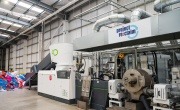The future of MRFs: Sorted
The need for greater quality and operational efficiency is driving technology developments at material recovery facilities. What does the future hold for recycling kit, asks Will Simpson
One of the many predictions prior to the adoption of the MRF Code of Practice in 2015 was that operators would either have to invest heavily in new technology to meet the new reporting requirements or go bust. More than two years down the line it is clear that whilst the fears of mass closure of MRFs have, thankfully, not come to pass, some parts of the sector are indeed gradually becoming more high-tech.
The most widespread new piece of kit that’s been adopted over the last five to ten years has been optical sorting systems. These – especially Near Infra Red (NIR) technology – were initially introduced within the plastics stream to separate the various polymer types, but more recently their use has also spread to paper and card.
“We’ve really seen them grow – especially with the bigger MRFs,” confirms Alan Harvey, Sales Manager of Pellenc ST, a French multinational that manufactures NIR systems. “They’re becoming more and more prevalent, especially whenever anyone is doing MRF upgrades. What we’ve seen is that to get to the standard that people need – the 98-99 per cent purities that people need to have a sellable product – NIR is the only way forward.”

Not as common, but starting to be seen more, is a glass clean-up separator, manufactured by Dutch company Nihot, called the SDS-i. This is a ‘plug and play’ piece of technology; multiple SDS can be used in tandem, depending on the final specifications required by the MRF. Meanwhile Nashville-based manufacturer NRT have introduced ‘PET Boost’, which improves the detection of thin-walled PET, wet PET and full-sleeved PET bottles by utilising algorithms to boost weaker detection signals on sorters.
As mentioned, a major driver in these developments has been the MRF code of conduct. “The code has enabled MRF operators to be compared against one another,” explains Georgina Cullen, Business Development Director at Leicester-based processor Casepak. “Market forces dictate that those that can demonstrate better quality outputs will be able to command preferential treatment from reprocessors, while those offering lower quality outputs may not achieve a good market price.”
“Consequently the code has also created an imperative for MRF operators to improve the quality of processed materials. In recent years, new technology, such as optical sorting equipment and electromagnetic sorters, has been widely embraced to improve the quality of outputs. The code has definitely created an impetus towards further technological development which has benefited the whole sector.”
But there have been other factors. Gavin Russell, Sales Engineer at the UK arm of Norwegian manufacturer Tomra, points a finger at the living wage: “Wage bills for MRF owners are set to rise by 15 per cent for any staff member over the age of 25. Inevitably, owners have had to look at ways of reducing their reliance on manual labour in order to remain competitive.”
Then there are outside forces, in particular the Chinese National Sword campaign, clamping down on imports of low-quality recyclates. “It’s been a significant driver,” claims Recoup CEO Stuart Foster. “There are reports that they are looking to ban imports of a number of plastics by the end of the year. If that happens then that might really change the landscape because, frankly, we don’t have the capacity in the UK to handle all that material. We would need to make sure that the quality of the material that is supplied is appropriate for a UK or European infrastructure, which would mean investing in new technology.”
The big question though is whether new technology has made the difference in terms of quality. Some, like Sam Reeve, Director of Resource Futures, are unsure: “I don’t think the data has shown that it’s improved, though its still an evolving picture.” Meanwhile, Alan Harvey, speaking from a manufacturer’s perspective, is more positive, saying: “All I know is that we’re being requested to get qualities for our customers up to around the 98 per cent mark. That is from a base of around the 90 per cent mark. So in that sense the adoption of NIR and other optical sorters has made the difference.”
It’s also unclear whether new technology has enabled UK MRFs to make any headway on difficult to recycle items, such as black and film plastics. Even NIR sorters have problems picking the former, as black material absorbs light. A new product manufactured by NRT may eventually provide a solution – their new ColorPlus-R sorter can detect black plastics through colour analysis using both transmissive and reflective light sources. The EU has also provided £1.47 million in funding to the NIRSort consortium led by Lincolnshire plastics recycler Luxus to develop NIR-detectable alternatives to black plastic for use across Europe.
As for plastic film, Oregon-based manufacturers Bulk Handling Systems (which supplies Casepak, among others in the UK) have, in partnership with NRT and Nihot, developed a product to aid its sorting called Fiber Pure. Peter Raschio, BHS Marketing Manager, explains: “An NRT SpydIR detects plastic film while in flight and ejects it upwards. The optical sorter’s integrated flight trajectory control system controls the aerodynamics to prevent swirling airflow, which as you can imagine, could otherwise pose a problem for this lightweight material. A Nihot Aspirator is attached to the back of the NRT SpydIR enclosure, and pneumatically extracts and conveys the lightweight plastic film to a Nihot Rotary Air Separator. Heavier plastics, typically containers, are collected separately from the aspirated stream and are routed to the container line for sorting, leaving the film fibre.”
The next decade will undoubtedly see further advances. Foster predicts that plastics sorting will be further refined through a ‘tagging and inking’ RFID (radio frequency identification) system: “It’s still at the research stage, but it effectively embeds finger prints into the product and uses a machine to see what that product might be.”
The main development will surely be the onward creep of AI technology. Bulk Handling Systems are at the forefront of this with a system called Max-AI (below). It comes in two parts. The first is a ‘Max Vision system’ that provides a detailed, comprehensive analysis of the material that will be processed and uses intelligent technology to optimise performance throughout the MRF. “This can be used before commodities are baled to analyse and certify the purity level,” says Peter Raschio. “Real-time knowledge of material type, quantity and location will drive automatic equipment adjustments, such as in-feed speed, screen angle, conveyor speed, air and optical settings, baler settings, and so on.”
Meanwhile the ‘Max-AI AQC (autonomous quality control)’ adds a robotic sorter that can make up to six sorts in one action. “NIR technology can identify and separate PET and even a colour in one step, but the AQC will actually separate green PET, blue PET, PET trays, aluminium, mixed plastics and residue, leaving a clean stream of clear PET on the belt – and that’s with one piece of equipment.”
BHS has already set up an AQC unit at an Athens Services MRF in California with another planned in San Jose. It seems inevitable that, eventually, they will arrive on this side of the Atlantic. It could well be that in another ten years’ time MRFs will have barely any human workers and optical sorters themselves are seen as archaic. By then, UK MRFs may well have finally solved those longstanding quality issues.



